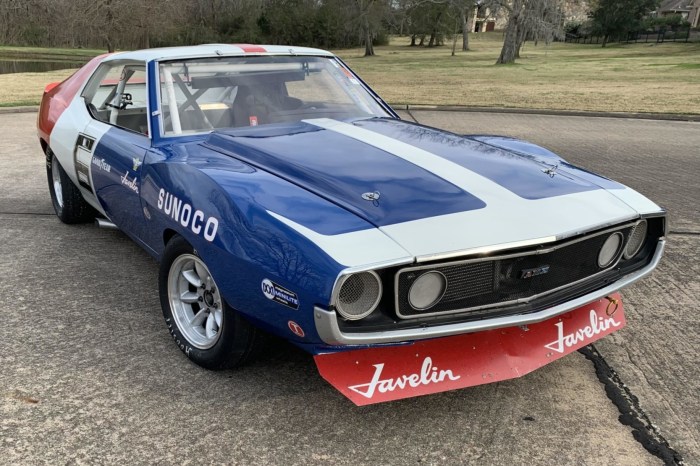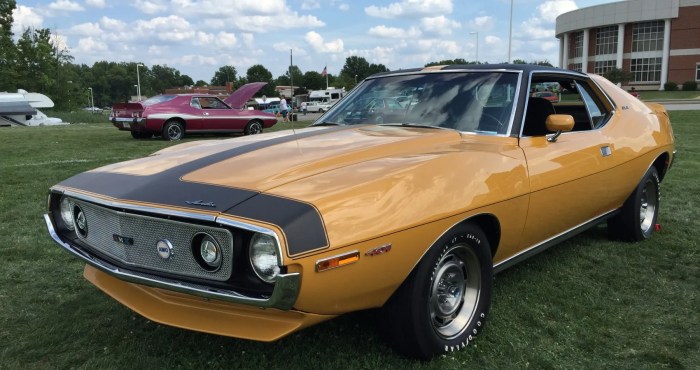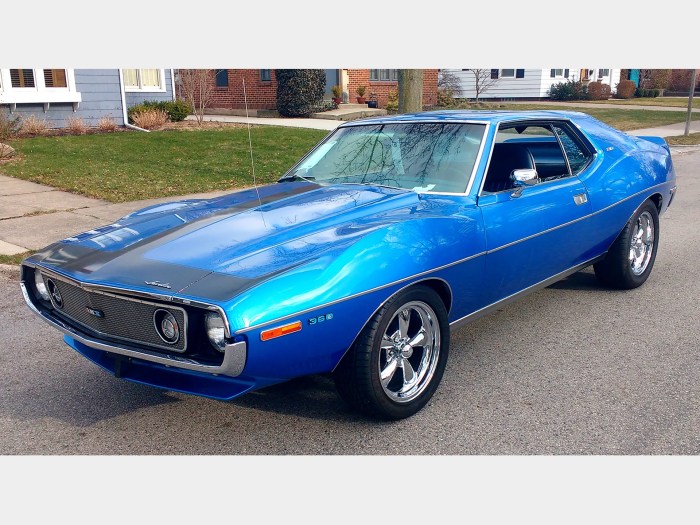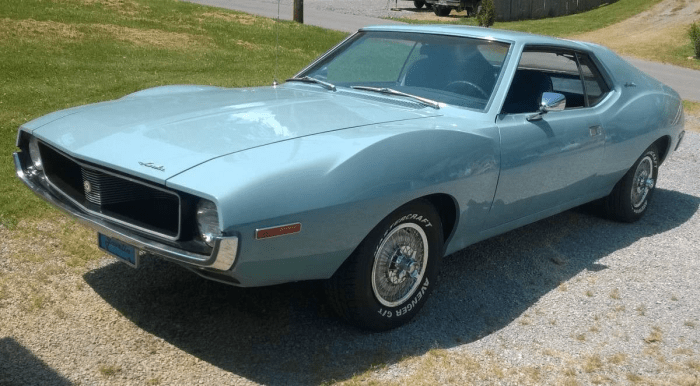The 1971 AMC Javelin bursts onto the scene as a bold statement in the muscle car era, a time when horsepower reigned supreme. American Motors Corporation (AMC) dared to challenge the established giants with a sleek, aerodynamic design that aimed to redefine performance and style.
The Javelin, with its distinctive grille and sharp lines, offered a compelling alternative to the Detroit behemoths, appealing to a younger generation seeking something different.
This wasn’t just a car; it was a symbol of rebellion, of a desire to break free from the status quo. AMC targeted a market hungry for innovation and excitement, using marketing campaigns that emphasized the Javelin’s agility and performance, rather than brute force.
The Javelin’s success in racing, particularly with the iconic Mark Donohue Edition, solidified its place as a true performance machine.
Introduction to the 1971 AMC Javelin

The 1971 AMC Javelin emerged into a dynamic automotive landscape characterized by the muscle car era’s waning influence and the growing popularity of sporty coupes. While the era of powerful V8s was still in full swing, fuel economy concerns and tightening emissions regulations were beginning to influence the industry.
This shift in the automotive market provided an opportunity for American Motors Corporation (AMC) to introduce a car that catered to a new generation of buyers seeking performance and style without the gas-guzzling drawbacks of traditional muscle cars.The Javelin, with its sleek, European-inspired design and a range of engine options, was a significant departure from AMC’s previous offerings.
The car was designed to be a more affordable and fuel-efficient alternative to the big-block muscle cars dominating the market, appealing to younger buyers and those looking for a more practical and stylish option.
The Javelin’s Design and Engineering Innovations
The Javelin’s design, penned by AMC’s in-house design team, was a bold statement in the automotive world. The car’s low-slung profile, fastback roofline, and prominent grille gave it a sporty and aggressive appearance that was unlike anything else on the market.
The Javelin’s aerodynamic shape was a departure from the boxy designs of many American cars of the time, contributing to its fuel efficiency.AMC’s engineers also focused on creating a car that was both fun to drive and practical. The Javelin’s independent front suspension provided precise handling, while its standard rear suspension offered a comfortable ride.
The car’s compact size and roomy interior made it a practical choice for everyday driving.
The Javelin’s Target Audience and Marketing Strategies
AMC targeted the Javelin at younger buyers, particularly those seeking a more affordable and stylish alternative to the muscle cars of the day. The company also aimed to appeal to buyers who were concerned about fuel economy and emissions.
AMC’s marketing campaign for the Javelin emphasized its sporty styling, performance, and practicality. The company also used innovative marketing strategies, such as sponsoring racing events and partnering with popular music artists.
The 1971 AMC Javelin was a popular muscle car that helped AMC gain a foothold in the performance market. While the Javelin was a coupe, AMC also produced the Marlin, a four-door fastback that offered a unique blend of style and practicality.
The 1967 AMC Marlin was a bold departure from the typical American sedan, and its influence can be seen in the Javelin’s sleek design. Both cars were designed to attract buyers who wanted something different from the usual Detroit offerings.
Design and Styling: 1971 AMC Javelin

The AMC Javelin, introduced in 1968, quickly established itself as a stylish and sporty coupe, challenging the dominance of established muscle car brands like Ford and Chevrolet. Its design, penned by Richard Teague, embodied a blend of aggressive styling and refined elegance, setting it apart from its competitors.
Exterior Design
The Javelin’s exterior design was characterized by its distinctive grille, headlights, and body lines. The grille featured a prominent, horizontal chrome bar with a large AMC emblem, flanked by two rectangular headlights. The body lines were clean and flowing, with a low, sloping roofline and a prominent rear haunch.
The 1971 AMC Javelin, a sporty coupe known for its distinctive styling and performance, was a significant model for American Motors Corporation. It was followed by the larger, more luxurious 1973 AMC Matador , which aimed to compete in the mid-size market.
Despite the Matador’s success, the Javelin remained a popular choice for those seeking a more compact and agile driving experience.
The Javelin’s profile was accentuated by a pronounced character line that ran from the front fender to the rear taillights. This unique combination of elements gave the Javelin a distinctive and sporty appearance.
The 1971 AMC Javelin, with its muscular lines and performance-oriented engine, became a popular choice for muscle car enthusiasts. While the Javelin was a sporty coupe, AMC also offered the compact 1975 AMC Gremlin , a more fuel-efficient option that appealed to a different demographic.
Despite their contrasting styles, both cars showcased AMC’s innovative approach to automotive design during a period of significant change in the American auto industry.
Styling Comparisons
Compared to other muscle cars of the era, the Javelin offered a more refined and sophisticated aesthetic. While rivals like the Ford Mustang and Chevrolet Camaro emphasized brute force and aggression, the Javelin presented a more elegant and athletic persona.
Its sleek lines and restrained use of chrome contrasted with the more muscular and ostentatious styling of its competitors. This subtle approach to styling appealed to a wider range of buyers, including those seeking a more refined and sophisticated sports car experience.
Interior Design
The Javelin’s interior design focused on driver comfort and functionality. The dashboard was designed with a driver-centric layout, featuring a large speedometer and tachometer prominently displayed in front of the driver. The instrument panel was clean and uncluttered, with easy-to-read gauges and controls.
The seats were comfortable and supportive, offering a balance of comfort and sportiness. The Javelin’s interior materials were of good quality, with vinyl upholstery and trim that were both durable and stylish.
Performance and Powertrain

The 1971 AMC Javelin was offered with a range of engine options, catering to diverse driving preferences and performance expectations. These engines, paired with various transmission choices, provided a balance of power, efficiency, and driving experience.
Engine Options
The 1971 Javelin was available with three engine options:
- 258 cu in (4.2 L) I6:This base engine generated 145 hp and 225 lb-ft of torque. It was known for its reliability and fuel efficiency, making it suitable for everyday driving.
- 304 cu in (5.0 L) V8:This mid-range option offered a significant power boost, producing 150 hp and 265 lb-ft of torque. It provided a more spirited driving experience, enhancing the Javelin’s acceleration and overall performance.
- 360 cu in (5.9 L) V8:The top-of-the-line engine delivered the most potent performance, generating 245 hp and 345 lb-ft of torque. This engine was designed for enthusiasts seeking thrilling acceleration and a powerful driving experience.
Transmission Choices
The 1971 Javelin was available with a selection of transmissions, each offering distinct advantages:
- Three-speed manual:This standard transmission provided a basic driving experience, suitable for everyday commuting and fuel efficiency.
- Four-speed manual:This option offered a more engaging driving experience, allowing for better control and acceleration.
- Three-speed automatic:This transmission provided smooth and effortless driving, ideal for comfortable cruising and city driving.
Performance Comparison
The 1971 Javelin’s performance varied significantly depending on the chosen engine and transmission. Compared to its competitors, such as the Ford Mustang and Chevrolet Camaro, the Javelin generally offered a more balanced approach, prioritizing handling and maneuverability over outright acceleration.
The 1971 Javelin with the 360 cu in V8 engine and four-speed manual transmission could achieve a 0-60 mph time of around 7.5 seconds and a top speed of approximately 115 mph.
While not the fastest in its class, the Javelin’s agile handling and responsive steering made it a fun and engaging car to drive. Its relatively lightweight construction and well-balanced chassis contributed to its precise and predictable handling characteristics.
Notable Features and Options

The 1971 AMC Javelin offered a range of features and options that catered to diverse buyer preferences, from performance enthusiasts to those seeking comfort and style. These included unique packages, special editions, and a selection of luxury amenities.
Performance and Style Packages
The 1971 Javelin was available with several packages designed to enhance its performance and visual appeal.
- AMX Package:This package transformed the Javelin into a high-performance sports car. It included a 390 cubic-inch V8 engine producing 325 horsepower, a four-speed manual transmission, a limited-slip differential, and unique suspension tuning. The AMX package also featured distinctive styling elements such as a blacked-out grille, a rear spoiler, and side stripes.
- Mark Donohue Edition:This special edition was named after the legendary race car driver, Mark Donohue. It was based on the AMX package but included additional performance enhancements, such as a special camshaft, a larger carburetor, and a revised exhaust system. The Mark Donohue Edition also featured a unique paint scheme with a white body, blue stripes, and a gold “Mark Donohue” signature on the hood.
Luxury and Comfort Features
The 1971 Javelin offered a variety of luxury and comfort features that were not typically found in other sports cars of the time.
- Air Conditioning:Air conditioning was an optional feature on the Javelin, providing a welcome respite from the heat, especially during long drives.
- Power Steering:Power steering was also an option, making the Javelin easier to maneuver, particularly in city driving.
- Vinyl Roof:A vinyl roof was available in a variety of colors, adding a touch of elegance and sophistication to the Javelin’s appearance.
- Bucket Seats:The Javelin came standard with bucket seats, offering excellent support and comfort for the driver and front passenger.
- Center Console:A center console was available as an option, providing a convenient storage space for small items and a more upscale feel to the interior.
Safety Features
Safety was a growing concern in the early 1970s, and the 1971 Javelin incorporated several safety features that were considered advanced for the time.
- Disc Brakes:Front disc brakes were standard on the Javelin, providing superior stopping power compared to drum brakes.
- Energy-Absorbing Steering Column:The Javelin featured an energy-absorbing steering column designed to minimize injuries to the driver in the event of a crash.
- Safety Belts:The Javelin came standard with safety belts, which were becoming increasingly common in vehicles.
Legacy and Cultural Impact

The AMC Javelin left an indelible mark on American automotive culture, carving a niche for itself as a stylish, sporty, and affordable muscle car. Its legacy extends beyond its initial production run, influencing subsequent generations of AMC vehicles and captivating enthusiasts for decades.
Racing Heritage and Enthusiast Appeal, 1971 AMC Javelin
The Javelin’s performance and handling made it a popular choice for racing, particularly in the Sports Car Club of America (SCCA) Trans-Am series. Its lightweight design and powerful engine enabled it to compete with heavier, more established muscle cars. The Javelin’s success on the track helped to establish AMC as a serious contender in the performance car market.
The Javelin’s performance and affordability made it a popular choice among enthusiasts, who appreciated its unique styling and driving experience. This loyal following helped to sustain the Javelin’s popularity long after its production ended.
Cultural Impact and Media Presence
The Javelin’s distinctive styling and sporty image made it a frequent fixture in popular culture. It appeared in numerous films, television shows, and music videos, often representing the spirit of rebellion and freedom associated with the muscle car era. The Javelin’s presence in these media outlets helped to solidify its place in American automotive history.
Closing Notes

The 1971 AMC Javelin remains a compelling testament to AMC’s daring vision. It carved a unique niche in the muscle car landscape, offering a blend of style, performance, and affordability. The Javelin’s legacy continues to resonate with car enthusiasts, reminding us that sometimes, a bold move can lead to a lasting impact.